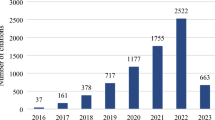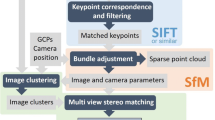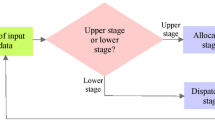Abstract
In forestry, the highest operational costs arise from the construction of forest roads and the transportation of harvested wood. Hence, optimization models have been used at the tactical level of planning to reduce these costs by integrating decisions on: (1) the allocation of harvest-blocks, (2) the allocation of access roads to these blocks, and (3) the transportation costs that result from the latter two decisions. The integration of these three decisions, in one optimization model, has been referred to as the integrated model. The integrated model, when binary decision variables are used to represent the cut-blocks and roads, is NP-hard and has been solved using two approaches: exact and metaheuristic algorithms. Unlike exact methods, metaheuristic algorithms have thus far not solved the integrated model, but have solved models which either exclude transportation costs from the objective function, or solve the model sequentially. This is a significant gap in prior research because exact solution methods can only be used on smaller forests and metaheuristic algorithms have therefore been used to solve the tactical forest planning problem, without the integration of transportation costs, on large forests. This failure to integrate transportation costs, on a large scale, is the major economic consequence of this gap. The objective of this paper is to present and evaluate a new solution procedure in which all three elements of the integrated tactical planning model are included in the objective function and solved using metaheuristics. The solution procedure was applied to three forests and the attributes and qualities of the solutions were compared to near-optimal solution values generated using an exact solution approach. The results indicate that this metaheuristic procedure generated good quality solutions. We conclude that this research is a useful first step in representing transportation costs in the integrated tactical planning models to be solved using metaheuristics.









Similar content being viewed by others
References
Andalaft N, Andalaft P, Guignard M, Magendzo A, Wainer A, Weintraub A (2003) A problem of forest harvesting and road building solved through model strengthening and Lagrangean relaxation. Oper Res 51:613–628
Anderson AE, Nelson J (2004) Projecting vector-based road networks with a shortest path algorithm. Can J For Res 34:1444–1457
Armstrong GW (2014) Considerations for boreal mixedwood silviculture: a view from the dismal science. For Chron 90:44–49
Bettinger P, Boston K, Sessions J (1999) Intensifying a heuristic forest harvest scheduling search procedure with 2-opt decision choices. Can J For Res 29:1784–1792
Bettinger P, Sessions J, Boston K (2009) A review of the status and use of validation procedures for heuristics used in forest planning. Math Comput For Nat Resour Sci 1:26–37
Bjørndal T, Herrero I, Newman A, Romero C, Weintraub A (2012) Operations research in the natural resource industry. Int Trans Oper Res 19:39–62
Borges P, Eid T, Bergseng E (2014) Applying simulated annealing using different methods for the neighborhood search in forest planning problems. Eur J Oper Res 233:700–710
Boston K, Bettinger P (1999) An analysis of Monte Carlo integer programming, simulated annealing, and tabu search heuristics for solving spatial harvest scheduling problems. For Sci 45:292–301
Chung W, Sessions J (2003) NETWORK 2000: a program for optimizing large fixed and variable cost transportation problems. In: Arthaud GJ, Barrett TM (eds) Systems analysis in forest resources. Managing Forest Ecosystems, vol 7. Springer, Dordrecht, pp 109–120
Chung W, Dykstra D, Bower F, O’Brien S, Abt RM, Sessions J (2012) User’s guide to SNAP for ArcGIS: ArcGIS interface for scheduling and network analysis program. USDA Forest Service PNW-GTR-847, 34 pp
Clark MM, Meller RD, McDonald TP (2000) A three-stage heuristic for harvest scheduling with access road network development. For Sci 46:204–218
Crowe K, Nelson JD, Boyland M (2003) Solving the area-restricted harvest-scheduling model using the branch and bound algorithm. Can J For Res 33:1804–1814
Dahlin B, Sallnäs O (1993) Harvest scheduling under adjacency constraints—a case study from the Swedish sub-alpine region. Scand J For Res 8(1–4):281-290
Dijkstra EW (1959) A note on two problems in connection with graphs. Numer Math 1:269–271
Ghamlouche I, Crainic TG, Gendreau M (2003) Cycle-based neighbourhoods for fixed-charge capacitated multicommodity network design. Oper Res 51:655–667
Goycoolea M, Murray A, Vielma JP, Weintraub A (2009) Evaluating approaches for solving the area restriction model in harvest scheduling. For Sci 55:149–165
Guignard M, Ryu C, Spielberg K (1998) Model tightening for integrated timber harvest and transportation planning. Eur J Oper Res 111:448–460
Jones JG, Hyde JFC, Meacham ML (1986) Four analytical approaches for integrating land management and transportation planning on forest lands. Research Paper INT-36 l, USDA Forest Service, Intermountain Research Station, 32 pp
Kirby MW, Wong P, Hager WA, Huddleston ME (1980) Guide to the integrated resources planning model. Technical report, Berkeley, California, USA
Kirby MW, Hager WA, Wong P (1986) Simultaneous planning of wildland management and transportation alternatives. TIMS Stud Manag Sci 21:371–387
Kirkpatrick S (1984) Optimization by simulated annealing: quantitative studies. J Stat Phys 34:975–986
Lockwood C, Moore T (1993) Harvest scheduling with spatial constraints: a simulated annealing approach. Can J For Res 23:468–478
Magnanti TL, Wong RT (1984) Network design and transportation planning: models and algorithms. Transp Sci 18:1–55
Martin JA (1971) The relative importance of factors that determine log-hauling costs. USDA Forest Service Research Paper NE-197. Northeastern Forest Experimental Station, Upper Darby, PA, 18 pp
McDill ME, Rebain SA, Braze J (2002) Harvest scheduling with area-based adjacency constraints. For Sci 48:631–642
Murray AT (1999) Spatial restrictions in harvest scheduling. For Sci 45:45–52
Murray AT, Church RL (1995) Heuristic solution approaches to operational forest planning problems. OR-Spektrum 17:193–203
Naderializadeh N, Crowe KA (2018) The effect of the density of candidate roads on solutions in tactical forest planning. Can J For Res 48:679–688
Naderializadeh N, Crowe KA (2020) Formulating the integrated forest harvest-scheduling model to reduce the cost of the road-networks. Oper Res Int J 20:2283–2306
Nelson J, Brodie JD (1990) Comparison of a random search algorithm and mixed integer programming for solving area-based forest plans. Can J For Res 20:934–942
Öhman K, Eriksson LO (1998) The core area concept in forming contiguous areas for long-term forest planning. Can J For Res 28:1032–1039
Reeves CR (1993) Modern heuristic techniques for combinatorial problems. Wiley, Hoboken
Richards EW, Gunn EA (2000) A model and tabu search method to optimize stand harvest and road construction schedules. For Sci 46:188–203
Richards EW, Gunn EA (2003) Tabu search design for difficult forest management optimization problems. Can J For Res 33:1126–1133
Silva MG, Weintraub A, Romero C, De la Maza C (2010) Forest harvesting and environmental protection based on the goal programming approach. For Sci 56:460–472
Tarp P, Helles F (1997) Spatial optimization by simulated annealing and linear programming. Scand J For Res 12:390–402
Van Deusen PC (1999) Multiple solution harvest scheduling. Silva Fenn 33:207–216
Van Deusen PC (2001) Scheduling spatial arrangement and harvest simultaneously. Silva Fenn 35:85–92
Veliz FB, Watson JP, Weintraub A, Wets RB, Woodruff DL (2015) Stochastic optimization models in forest planning: a progressive hedging solution approach. Ann Oper Res 232:259–274
Weintraub A, Navon D (1976) A forest management planning model integrating silvicultural and transportation activities. Manag Sci 22:1299–1309
Acknowledgements
We thank NSERC, MITACS Canada, and aiTree Ltd. for funding this research. We also thank Waqas Ghouri, Timber Pricing Specialist and Tom Harries, Forest Industry Liaison Officer, from the Ontario Ministry of Natural Resources and Forestry (OMNRF) for sharing information about the parameters required to examine our model for this paper.
Author information
Authors and Affiliations
Corresponding author
Additional information
Publisher's Note
Springer Nature remains neutral with regard to jurisdictional claims in published maps and institutional affiliations.
Rights and permissions
About this article
Cite this article
Naderializadeh, N., Crowe, K.A. & Rouhafza, M. Solving the integrated forest harvest scheduling model using metaheuristic algorithms. Oper Res Int J 22, 2437–2463 (2022). https://doi.org/10.1007/s12351-020-00612-3
Received:
Revised:
Accepted:
Published:
Issue Date:
DOI: https://doi.org/10.1007/s12351-020-00612-3




